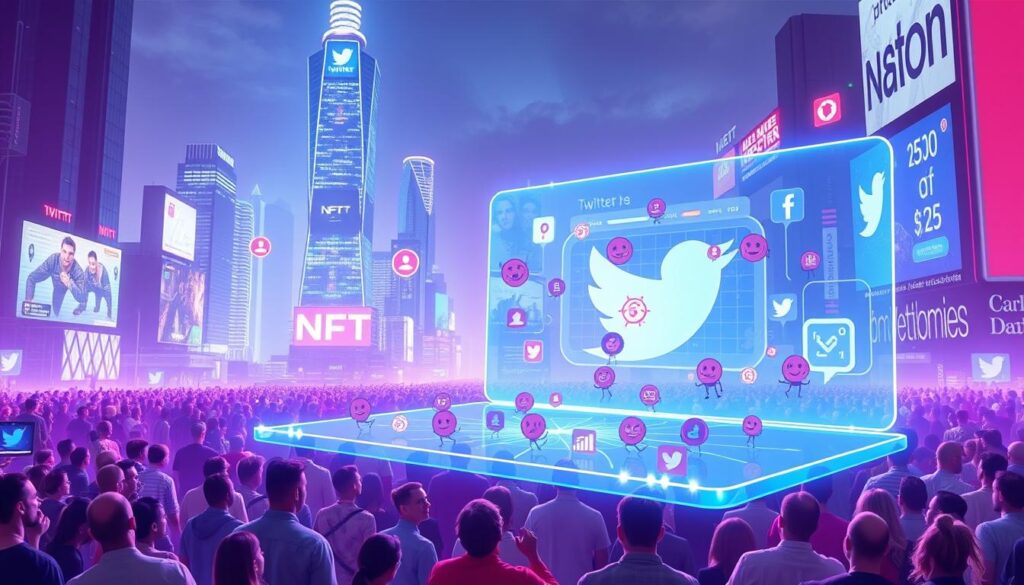Now Reading: How NFT Royalty Systems Help Artists Earn More
- 01
How NFT Royalty Systems Help Artists Earn More
How NFT Royalty Systems Help Artists Earn More

For decades, artists faced a harsh reality: sell a piece once, lose control forever. Digital creators struggled even more as their work spread online without compensation. Now, blockchain technology offers a groundbreaking solution. New tools let creators earn recurring income every time their art changes hands.
These innovations use self-executing smart contracts to track sales across platforms. When a digital collectible resells, a percentage automatically routes back to the artist. This model flips traditional art economics, rewarding creators for lasting value rather than single transactions.
Major marketplaces like OpenSea and Magic Eden have adopted these protocols, though approaches vary. Some platforms enforce payments through code-level restrictions, while others rely on community incentives. Legal experts note these systems operate in uncharted territory, blending property rights with decentralized tech.
Forward-thinking brands are leveraging digital collectibles to build deeper fan connections. Musicians release album art with built-in revenue streams, while illustrators see monthly income from viral pieces. Yet challenges remain – from marketplace competition to evolving regulations.
Key Takeaways
- Smart contracts enable automatic payments to creators on secondary sales
- Royalty percentages typically range from 5-10% per resale transaction
- Enforcement methods vary across blockchain platforms and marketplaces
- Legal status remains undefined under current intellectual property laws
- Adoption challenges include platform compliance and collector incentives
Introduction to NFT Royalty Systems
Blockchain innovation has transformed how creators profit from their digital work. Unlike traditional models where payments stop at the first transaction, new protocols enable ongoing earnings through automated agreements. This shift empowers artists to benefit as their creations gain value over time.

Redefining Ownership in the Digital Space
Non-fungible tokens verify authenticity through decentralized ledgers, solving the copy-paste problem of digital files. Each token acts as a certificate of ownership, traceable across every transaction. Popular examples include:
- Animated collectibles with provable rarity
- Music tracks with embedded revenue streams
- Virtual real estate in metaverse platforms
This technology creates artificial scarcity for digital content, letting creators control distribution. When someone buys these tokens, the original maker maintains a financial stake through coded agreements.
From Single Sales to Lifetime Earnings
Traditional art markets only paid creators during initial purchases. Blockchain changes this by automatically routing percentages of resale prices back to makers. A 10% royalty on a $1,000 token means $100 goes to the artist whenever it changes hands.
Platforms execute these payments through self-managing contracts tied to each asset. As items trade in secondary markets, the system tracks movements without third-party involvement. This structure turns viral success into sustainable income rather than a one-time windfall.
Understanding How NFT Royalty Systems Work
Automated payment structures revolutionize how creators profit beyond initial sales. These frameworks use blockchain protocols to track ownership changes and distribute earnings transparently. At their core, programmable agreements ensure fair compensation without intermediaries.

The Role of Smart Contracts in Royalty Distribution
Self-executing code forms the backbone of these compensation models. When minting digital collectibles, artists embed rules that specify:
- Percentage cuts for resales (typically 5-10%)
- Wallet addresses for automatic transfers
- Conditions triggering payments
Blockchain lawyers note these agreements aren’t legal contracts but code-based triggers. When a transfer occurs on supported platforms, the system checks if it’s a sale. If confirmed, funds route instantly to predetermined recipients.
Mechanisms for Enforcing Secondary Sale Royalties
Current systems face a critical challenge: distinguishing sales from non-commercial transfers. Platforms use three primary methods:
- Marketplace-level compliance (voluntary fee collection)
- Token-gated restrictions (blocking unsupported transfers)
- Onchain validation (analyzing transaction patterns)
Most solutions depend on platform cooperation rather than blockchain enforcement. This creates gaps when items move between marketplaces with different policies. Emerging tools aim to detect genuine sales through transaction analysis, but technical limitations persist.
Smart Contract and Customization Details
The digital art revolution brings unprecedented control to creators through customizable blockchain tools. Developers can now program compensation rules directly into assets using self-executing agreements. This flexibility lets artists design payment structures matching their creative vision and market strategy.

Customizing Royalty Terms on the Blockchain
Smart contracts enable granular control over resale compensation. Creators set percentages through code, choosing between flat rates or dynamic models. Three common approaches include:
- Tiered structures (higher fees for premium buyers)
- Time-based reductions (decreasing percentages annually)
- Multi-recipient splits (sharing proceeds with collaborators)
Platforms like Ethereum and Solana offer template systems for beginners, while advanced users code bespoke solutions. Industry experts note early preference for perpetual terms now shifting toward finite durations – some lasting months, others decades.
Balancing Perpetual vs. Finite Royalty Settings
Endless revenue streams initially attracted creators, but market feedback revealed buyer resistance. Many collectors prefer limited-term arrangements, viewing them as fairer for long-held assets. Emerging solutions let artists:
- Sunset fees after specific resale counts
- Link percentages to inflation metrics
- Pause collections during market downturns
This evolution reflects maturing markets where both creators and buyers influence compensation designs. As blockchain tools advance, expect more adaptive systems responding to real-time sales data and community voting mechanisms.
Benefits and Revenue Opportunities for Artists
Digital creators now unlock lasting income streams through blockchain solutions that reward ongoing value. Unlike traditional art sales, these tools let makers earn whenever their work trades hands. A 10% cut from a $500 resale sends $50 directly to the artist’s wallet automatically.
Platforms using innovative royalty structures have paid creators over $1.4 million in two weeks for viral projects. Musicians like Jacques Greene earned thousands from short audio clips, proving even niche content can generate serious revenue. This model turns fleeting popularity into career-sustaining income.
Scarcity and authenticity drive value in digital markets. Blockchain verification ensures buyers support original creators, not copycats. As authenticating digital creations becomes standard, artists gain leverage in pricing negotiations.
Emerging standards like EIP 2981 aim to simplify royalty enforcement across platforms. While challenges remain, these systems empower creators to focus on their craft – knowing their work keeps paying dividends long after the first sale.
FAQ
How do creators earn from secondary sales of digital assets?
When a collector resells a digital asset on platforms like OpenSea or Rarible, a percentage of the sale price automatically goes to the original creator. This happens through blockchain-based smart contracts, which enforce payment terms without intermediaries.
What role do smart contracts play in royalty distribution?
Smart contracts execute pre-programmed rules embedded in blockchain tokens. For example, they can divert 10% of every resale to the creator’s wallet. Platforms like Ethereum and Solana enable this automation, ensuring transparent and instant payments.
Can royalty terms be changed after a digital asset is minted?
No. Once a token’s terms are set on blockchains like Flow or Tezos, they become immutable. Artists must define percentages upfront—popular choices range from 5% to 20%—using platforms like Foundation or SuperRare during the minting process.
How do blockchain-based royalties differ from traditional art royalties?
Traditional models rely on manual tracking and legal agreements, often leading to unpaid fees. Blockchain technology automates payments through code, eliminating third-party oversight. This shift empowers creators like Beeple or Pak to earn consistently from resales.
Are all marketplaces required to honor royalty payments?
No. While major platforms like Nifty Gateway enforce royalties, others like Magic Eden allow optional payments. Artists should research marketplace policies and use tools like Manifold Studio to embed enforceable terms directly into tokens.
What happens if a buyer avoids royalty fees by trading off-chain?
Off-chain transactions bypass smart contract logic, making royalty enforcement difficult. However, communities often self-regulate—collectors value provenance, and artists like XCOPY publicly denounce platforms that enable fee avoidance.
Can creators set time limits on royalty collection?
Yes. While most choose perpetual royalties, some use finite terms. For instance, generative artist Tyler Hobbs programmed a 10-year royalty window for specific works using custom smart contracts on Art Blocks.
Do royalty systems apply to all types of blockchain assets?
Primarily to ERC-721 and ERC-1155 tokens on Ethereum, and similar standards on other chains. Fungible tokens like Bitcoin or meme coins lack built-in royalty features since they’re interchangeable rather than unique.












